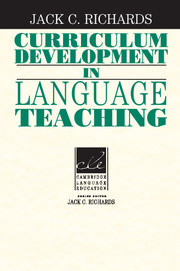Book contents
- Frontmatter
- Contents
- Series editor's preface
- Preface
- Credits
- 1 The origins of language curriculum development
- 2 From syllabus design to curriculum development
- 3 Needs analysis
- 4 Situation analysis
- 5 Planning goals and learning outcomes
- 6 Course planning and syllabus design
- 7 Providing for effective teaching
- 8 The role and design of instructional materials
- 9 Approaches to evaluation
- Author index
- Subject index
Series editor's preface
Published online by Cambridge University Press: 03 May 2010
- Frontmatter
- Contents
- Series editor's preface
- Preface
- Credits
- 1 The origins of language curriculum development
- 2 From syllabus design to curriculum development
- 3 Needs analysis
- 4 Situation analysis
- 5 Planning goals and learning outcomes
- 6 Course planning and syllabus design
- 7 Providing for effective teaching
- 8 The role and design of instructional materials
- 9 Approaches to evaluation
- Author index
- Subject index
Summary
The activities of language teaching have often been viewed from a very narrow perspective. This is evident from the fascination with teaching methods that has characterized the history of language teaching until relatively recently. Methods have often been regarded as the most important factor in determining the success of a language program, and advances in language teaching have sometimes been seen as being dependent on the adoption of the latest method. A perspective often missing from the method-based view of teaching is that of how methods interact with other factors in the teaching - learning process. Who are the learners and the teachers? What expectations do they have for the program? What learning and teaching styles do they bring to the program? For what purposes is the language needed? What goals does the program have, and how are these goals expressed? In what settings will teaching take place, and what organizational structure is in place to support and maintain good teaching? What resources will be used, and what are their roles? What is the role of textbooks and other materials? What measures will be used to determine the success of the program? Choice of teaching method cannot therefore be made unless a great deal is known about the context for the language program and the interactions between the different elements involved. It is this perspective that characterizes a curriculum-based approach to language teaching.
- Type
- Chapter
- Information
- Curriculum Development in Language Teaching , pp. ix - xPublisher: Cambridge University PressPrint publication year: 2001

